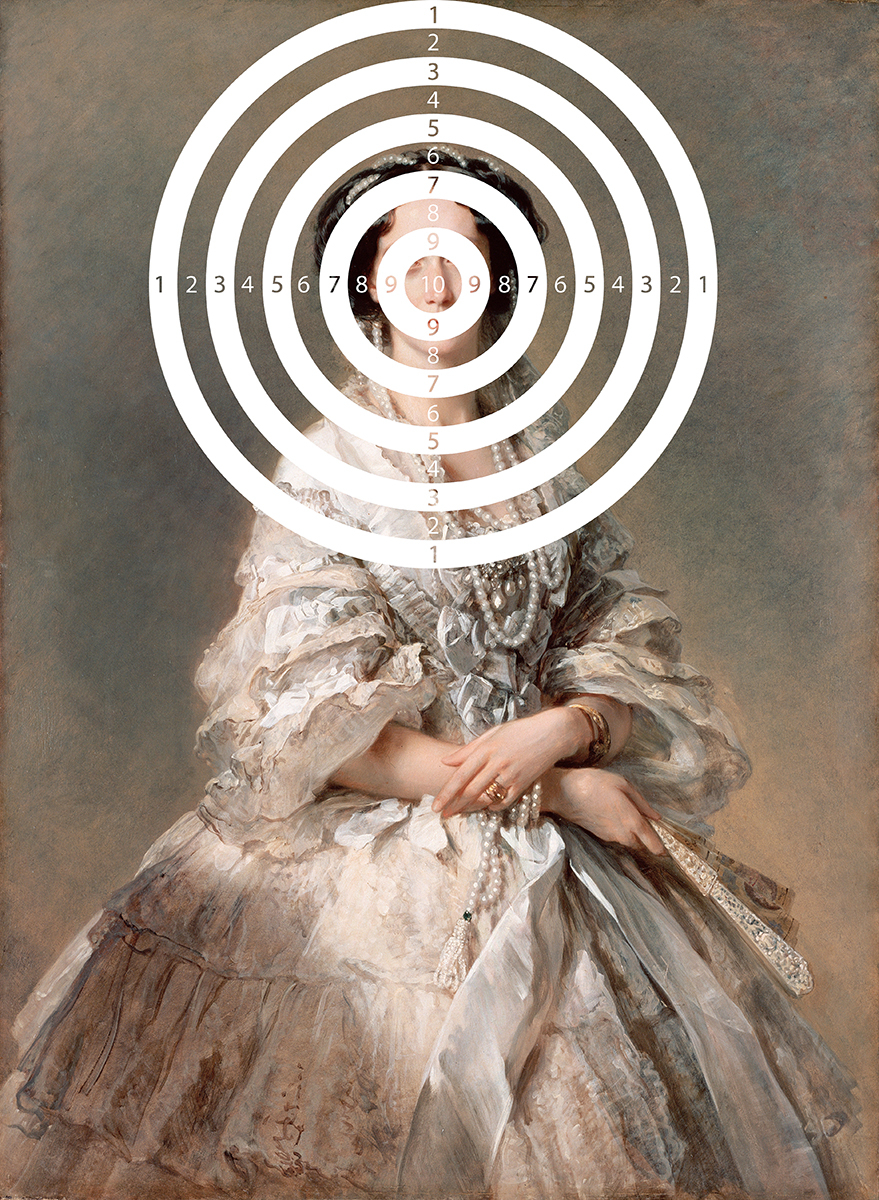The tabloid frenzy is compared to the bonfires of the past. Witches are replaced by the celebrities of the present, but the hatred fomented by the media burns as persistently as any fire.
The tabloid frenzy is compared to the bonfires of the past. Witches are replaced by the celebrities of the present, but the hatred fomented by the media burns as persistently as any fire.

In the 17th century, Puritan societies lived in fear of witches, women accused of collaborating with the devil to tear down the moral integrity of a community. Commanded by religious devotion, these societies were dens of suspicion for the female population, who lived under constant surveillance. Given the seriousness of the crime, the prosecution process was surprisingly frivolous. Talking to other women, the number of pets, a mole on the skin. The indications that a woman was a witch formed a guide of conduct that was impossible to follow. If the accusations were simple, the process of proving whether they were true was far more creative. Taking inspiration from medieval torture techniques, processes such as the "dip test" emerged. In this, a woman was stripped of her clothing and thrown into any body of water deep enough to submerge her. Aside from the latent risk of hypothermia, the purpose of the test was itself deadly: if a woman floated she was a witch, if she drowned she was innocent. The problem here is obvious: no matter what happened, the woman was doomed to die. If we have long since given up such barbaric methods to prove a woman's innocence, as a civilization we continue to look for arguments to vilify the female population. Think of female celebrities as illustrations of the scrutiny that all women have to tolerate. Witches are no longer accused, but celebrities are dethroned with equal fervor.
Day after day, history repeats itself to the point of becoming too frequent to ignore, a conclusion that is as irritating as it is frustrating. A female celebrity is catapulted into stardom: you can't listen to the radio without hearing her voice, use Instagram without seeing her face, or open a Vogue without recognizing her in some luxury brand's ad. It is when the young woman reaches this peak that malicious whispers arise. As her glory fades, these buzzers rise, becoming voices fixated on analyzing all the little mistakes this person makes, or has made, or will make. "How problematic is this behavior?", "What is she wearing?", "Success has gone to her head." If these criticisms appear as isolated observations, they quickly grow, driving a new common expectation: the public downfall of a said public figure. We mention Instagram and comments on social media, but the phenomenon far predates any notion of Youtube videos or TikTok. This behavioral pattern has been observed for centuries in women in positions of power, and we don't just mean witches. Take Catherine the Great, for example, who, despite all her proficiency as a monarch, is remembered for the grotesque rumor that she had sex with a horse. This rumor, refuted by simple laws of physics, was one of the many ways in which her enemies sought to attack her credibility.
You don't have to go back centuries to find this story repeated in one form or another. If we attempted to summarize all the cases in which something like this happened to a celebrity, we wouldn't have enough space. The cases are so diverse that the only perceptible common trait between these women is their fame. Consider Amy Winehouse, one of the most important soul singers of this century who, regardless of her talent, was dissected by the media due to her drug addiction. Her idiosyncratic character (she was deeply honest, even when faced with the violence of paparazzi flashes) made her beloved by both the public and the media. But over time, the supposed tenderness was replaced by aggressive scrutiny of her private life. Her weight, her relationships, her family, any topic was used by the tabloids, who looked for ways to justify her problems, without ever showing any trace of empathy. Of course, a woman doesn't need to exhibit troubling behaviors to be harassed, often the media themselves are in charge of finding (fixing?) said problems. Take Billie Eilish, for example, the young singer who rose to global success at the age of seventeen with the album When We Fall Asleep, Where Do We Go? With an alternative style, but a familiarity of mainstream pop, the American singer quickly became a star. If the hype lasted until the release of her second album, her luck ran out shortly after it came out. A video from when the singer was fourteen, in which Eilish offends part of the Asian population, was dug up from the confines of the Internet and set the torches of angry crowds ablaze. Soon after its release, dozens of allegations surfaced, each more far-fetched than the next: from accusations of queerbaiting (the act of pretending to be queer to create speculation), to "concerns" of the age difference with her boyfriend at the time, the tabloids were dedicated to knocking Billie Eilish off the pedestal they had placed her in. The list of motives grew by the day, with ever more ridiculous allegations and ever weaker arguments, leading the young artist to issue weekly press releases to address her latest "scandal." We mentioned Winehouse and Eilish, but so many other names could be listed. Ariana Grande, Lindsay Lohan, Miley Cyrus, Christina Aguilera, Selena Gomez, Britney Spears. It would probably be easier to list the number of famous young women who have not been forced to go through this bizarre ritual.
We could spend the rest of this article describing all the ways in which these celebrities have been scrutinized by the public, but the question remains: what lies behind this cycle? Our perplexity is comparable to that of the puritanical population of the past. However, unlike them, we appeal to logic rather than to heavenly providence. Milly Williamson, Vice President of Cultural Studies at Goldsmiths University, replaces the so-called divine solutions of old. The researcher, who focuses her research on media analysis, dissects the problem in two ways, the first going back to our cultural and ideological context. As she points out, "celebrities are merely reflections and dramatizations of what it is like to live as a woman in a patriarchal society." The answer, previously so chimerical, is elucidated by the academic in an interview with Vogue Portugal. "In a patriarchy, a woman is an impossibility, forced to exist sexually, but sanctioned by the absence of innocence," she explains. The academic jargon can be intimidating, but Williamson doesn't let the confusion linger, simplifying it with an analogy: "Consider a woman's breast. In physiological terms, this exists as a way to nourish her children, but at the same time it is sexualized by male perception." The metaphor immediately brings us back to the strange sexualization that women who breastfeed in public have to tolerate, accused of indecency while fulfilling the most natural purpose of this part of their body. It is through this example that Williamson elaborates on what she accuses of being at the root of the problem, the "virgin/prostitute dichotomy." "A woman is supposed to be innocent, modest, and virginal, but she is asked to be sexually available for the pleasure of the man," she explains. According to the professor, it is from this paradox that all the hatred towards female celebrities originates. If a famous woman doesn't reveal her body, she's not interesting - after all, only sex sells - but if she decides to show off her sensuality, she's promiscuous and obsessed with media attention. Like the "witches" of the past, famous women are doomed to failure before the trial even begins.
Williamson does not allow us to forget the second reason he indicated as the main perpetrator of this vicious cycle: economic interest. "Newspapers with the story of celebrities' personal lives have been sold for over two hundred years, but the current business model of online tabloids elevates this problem." In the world of the Internet, the formula for making money is simple: the more views and clicks you get, the more revenue you create. It is exactly because of this elementary equation that, as the British researcher points out, stories are "built." The researcher elaborates, "By putting celebrities on a pedestal and then tearing them down, the media create narratives, true soap operas in which their audience can participate." To designate the tabloids as the sole perpetrators of this system would be to reduce the complexity of the issue to the level of the narratives they are trying to sell. The media are only one piece of this cruel puzzle. Williamson introduces us to another protagonist, the agencies and studios that "protect" a celebrity's image. According to the scholar, there are real teams of people focused on controlling the way the public thinks about a famous person. But, as you might expect, it is not altruism that motivates these agencies, but rather the sale of the image of a said celebrity, often done independently of the celebrity's well-being. "Just think of most of the women who became celebrities when they were children." A good example is the so-called "Disney kids," infamous for going into spirals of out-of-control as soon as they come of age. The researcher provides an example: "Think of Miley Cyrus, a child television star who, as a child, has no sexual presence, and who, especially through Hannah Montana, is supposed to represent this ideal of not succumbing to the sins of fame. But as she enters her adult life this narrative is unworkable for the 'creators' of her image, who need her sexuality to continue to sell her name. What are they supposed to do?" Don’t be fooled by the question, Williamson has the answer to her own question, "These teams of people forgo the protection of celebrity, choosing instead to foment controversy to reintroduce her to the public as a sexy, rebellious woman." This marketing strategy is executed despite the celebrity's mental health, to the detriment of which she becomes part of the narrative. As soon as the researcher dissects this approach, two words escape our lips: Britney Spears. The singer is the epitome of a victim of this dizzying cycle of bullying. From attacks on her intelligence to questions about her promiscuity, the then-young artist was subjected to incessant scrutiny. Her reaction to this media pressure was not enough to stop them and was used as gasoline for the fire of the story that the tabloids were selling. The custody of her children, the conservatorship regime she was subjected to, and the complete loss of control over her own life, Spears became the embodiment of the harmful effects of the cycle of female fame.
The world changed and justice favored Spears who, after two decades, found herself vindicated before the public for the first time. The media attention she garnered created an expectation of change, a hope that from now on female celebrities will not be exploited in the same way. If this is an optimistic view of the future, Milly Williamson categorizes herself as a realist, refuting the hypothesis that Britney Spears' case will affect the future generation of artists. "The way the media once again formed a narrative, the innocent woman versus her evil father, clearing themselves of any blame along the way, is proof enough that they are not focused on changing their predatory attitude," explains the British researcher. If the case of Britney Spears, which so painfully demonstrates how fame can ruin a person's life, is not enough, then what is? For Williamson, the answer is clear: "Any progress has to come from outside celebrity culture." The researcher lists some of the most recent movements that have altered modern culture, such as #MeToo or Black Lives Matter, to justify her position. "Celebrity culture amplifies what is going on in society, it is the nature of the entertainment industry." For the British academic, the solution lies in a common effort: "We can't take progress for granted, if the global political climate tells us anything it's that change only happens when we make it happen."
Translated from the original on Vogue Portugal's The Innocence Issue, published February 2023.Full story and credits on the print issue.
Most popular





 (15).png)


